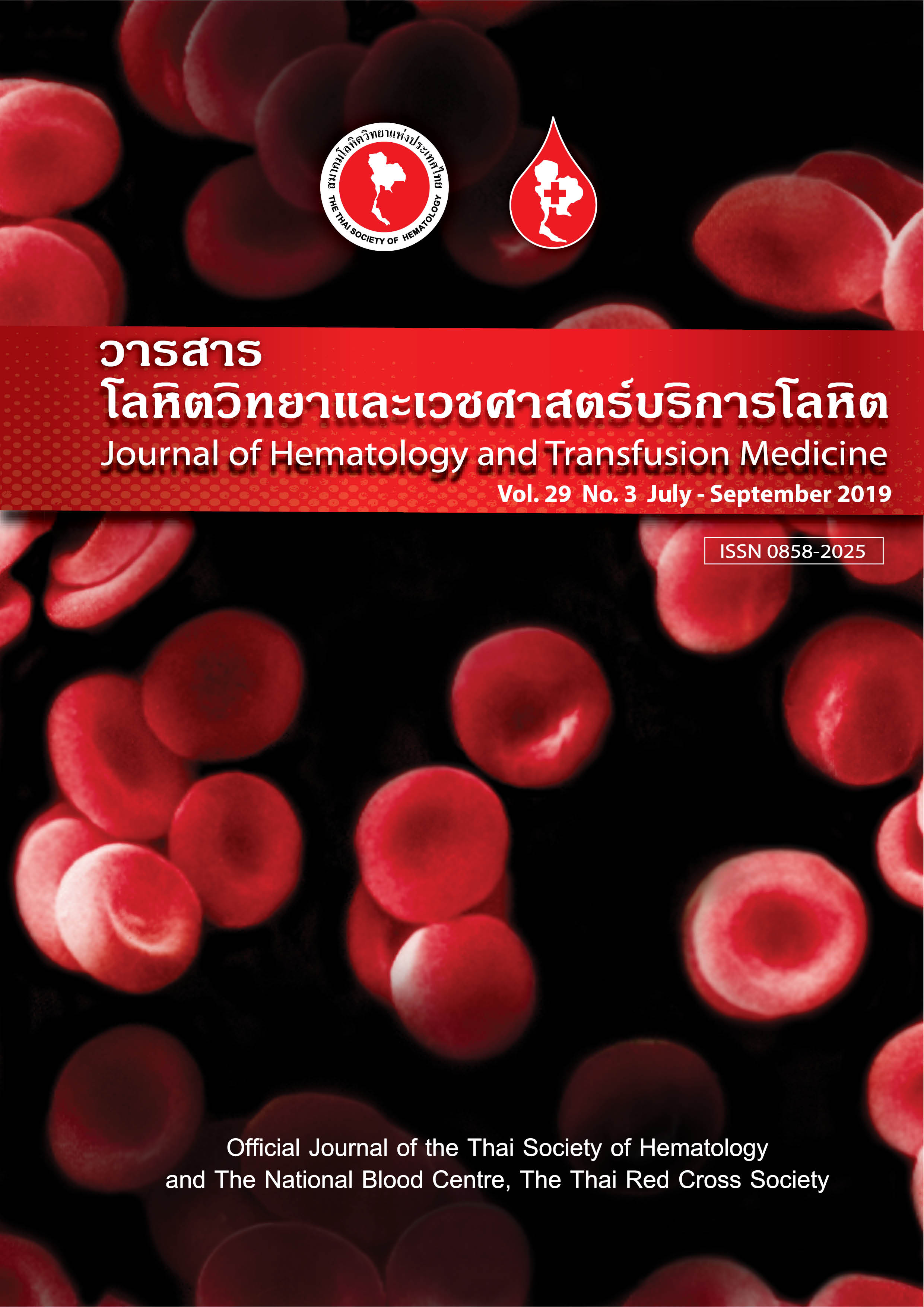การเปรียบเทียบคะแนนการจัดสรรไตจากค่า Panel reactive antibody (PRA) กับคะแนนการจัดสรรไตจากค่า calculated PRA (cPRA) ในผู้ป่วยรอปลูกถ่ายไต
Keywords:
Kidney transplantation, cPRA, Phenotypic bead, Single antigen bead, LuminexAbstract
บทคัดย่อ
บทนำ ค่าร้อยละของ Panel reactive antibody (PRA) เป็นหนึ่งในเกณฑ์การจัดสรรไตจากผู้บริจาคสมองตาย ค่า PRA ถูกคำนวณจากทดสอบด้วยน้ำยา phenotypic bead จากชุดตรวจสำเร็จรูป ปัจจุบันในต่างประเทศมีการนำค่า calculated PRA (cPRA) ซึ่งคำนวณได้จากแอนติบอดีจำเพาะที่ทดสอบด้วยน้ำยา single antigen bead (SAB) มาใช้แทนค่า PRA การนำ cPRA ที่คำนวณจาก phenotypic bead มาใช้แทน PRA ในผู้ป่วยชาวไทยจะมีผลต่อการจัดสรรไตอย่างไรนั้นยังไม่มีรายงานมาก่อน วัตถุประสงค์ เพื่อเปรียบเทียบคะแนนการจัดสรรไตจาก PRA และจาก cPRA โดยค่า cPRA คำนวณจาก unacceptable antigens ซึ่งได้มาจากแอนติบอดีจำเพาะโดยการตรวจด้วย phenotypic bead assay (cPRA-phenotypic bead) และ SAB assay (cPRA-SAB) โดยใช้ซีรัมเดียวกัน วัสดุและวิธีการ เก็บข้อมูลซีรัมจำนวน 243 ตัวอย่างที่มีผลการตรวจ HLA antibody ด้วย phenotypic bead และ SAB ครบทั้ง 2 วิธี จากตัวอย่างเลือดเดียวกัน นำคะแนนที่ได้จากค่า PRA cPRA-phenotypic bead และ cPRA-SAB มาวิเคราะห์ทางสถิติและเปรียบเทียบคะแนนที่ได้จากแต่ละวิธีด้วย Chi-square test ผลการศึกษา เมื่อเปรียบเทียบ cPRA-SAB กับ PRA พบว่า ในการจัดสรรไตมีจำนวนซีรัมที่ได้คะแนนเท่าเดิมร้อยละ 63.79 (155/243 ตัวอย่าง) และเมื่อใช้ cPRA-SAB แทน PRA จะมีซีรัมเลื่อนมาอยู่ในกลุ่มคะแนนสูงขึ้นร้อยละ 34.57 (84/243 ตัวอย่าง ) การเปรียบเทียบ cPRA-phenotypic bead กับ PRA พบว่า ในการจัดสรรไตมีจำนวนซีรัมที่ได้คะแนนเท่าเดิมร้อยละ 76.13 (185/243 ตัวอย่าง) และเมื่อใช้ cPRA-phenotypic bead แทน PRA จะมีซีรัมเลื่อนมาอยู่ในกลุ่มคะแนนสูงขึ้นร้อยละ 22.22 (54/243 ตัวอย่าง) โดยการเปลี่ยนแปลงคะแนนที่สูงขึ้นนี้ มีความเป็นไปได้ที่ส่วนหนึ่งเกิดจากความถี่ของแอนติเจนในประชากรไทย สูงกว่าความถี่ของแอนติเจนดังกล่าวบน phenotypic bead สรุป การใช้คะแนนจากค่า cPRA ในการจัดสรรไตจะส่งผลให้ผู้ป่วยซึ่งมีแอนติบอดีต่อแอนติเจนซึ่งมีความถี่สูงในประชากรไทยได้คะแนนจัดสรรไตเพิ่มขึ้น
Abstract:
Introduction: The panel reactive antibody (PRA) is one of Thai kidney allocation criteria for deceased donor’s kidney. PRA assay is tested by using phenotypic bead from commercial kit. However, many countries have been using calculated PRA (cPRA), which was calculated based on HLA antibody identified by single antigen bead (SAB) assay, instead of using PRA. The impact of using cPRA, calculated based on antibodies identified by phenotypic beads, instead of PRA in Thai population has not been reported. Objective: The aim of this study was to compare the kidney allocation score determined from PRA with those from cPRA of the same sera. Calculated PRA was based upon unacceptable antigens which were determined from HLA antibodies specified from SAB assay (cPRA-SAB) and from phenotypic bead assay (cPRA-phenotypic bead). Materials and methods: Data of 243 serum specimens evaluated by both SAB and phenotypic assays were collected and analyzed. The results of PRA, cPRA-SAB and cPRA-phenotypic bead were transferred into kidney allocation scores before the score comparison was done by using Chi-square test. Results: There were 243 samples that tested with both SAB assay and phenotypic bead assay. An analysis of allocation scores using cPRA-SAB instead of PRA demonstrated that the concordance rate was 63.79% (155/243 samples) and 34.57% of all samples (84/243 samples) received higher allocation scores. Further analysis of the allocation scores using cPRA-phenotypic bead instead of PRA demonstrated that the concordance rate was 76.13% (185/243 samples) and 22.22% of all samples (54 /243 samples) received the higher allocation scores. One of the possible reasons of discrepancy between the PRA and the cPRA scores was the higher rate of HLA frequencies in the Thai population than that in the phenotypic bead assay. Conclusion: The allocation score using cPRA will be beneficial to the sensitized patients who have antibodies to the high frequency antigen in the Thai population due to increased points of allocation scores.
Downloads
References
2. Kannabhiran D, Lee J, Schwartz JE, Friedlander R, Aull M, Muthukumar T, et al. Characteristics of circulating donor human leukocyte antigen-specific immunoglobulin G antibodies predictive of acute antibody-mediated rejection and kidney allograft failure. Transplantation. 2015;99:1156-64.
3. Regulation of the Organ Donation Centre, Thai Red Cross Society 2002. Available from: https://www.organdonate.in.th/Download/pdf/guideline.pdf. (access June 21, 2019).
4. Lachmann N, Todorova K, Schulze H, Schonemann C. Luminex® and its applications for solid organ transplantation, hematopoietic stem cell transplantation, and transfusion. Transfus Med Hemother. 2013;40:182-9.
5. Current CPRA Calculation [Internet]. UNOS [2011]. Available from:https://unos.org/wp-content/uploads/unos/CPRA_current_presentation.pdf. (access June 21, 2019).
6. Cecka JM. Calculated PRA (CPRA): the new measure of sensitization for transplant candidates. Am J Transplant. 2010;10:26-9.
7. Murphey CL, Forsthuber TG. Trends in HLA antibody screening and identification and their role in transplantation. Expert Rev Clin Immunol. 2008;4:391-9.
8. Phanish MK. Immunological risk assessment and human leukocyte antigen antibody testing in kidney transplantation. Indian J Nephrol. 2016;26:80-5.
9. Benjasupattananan P. Comparison study of calculated panel reactive antibody and flow cytometry-based panel reactive antibody in kidney transplant recipient waiting list [dissertation]. Bangkok: Chulalongkorn university; 2011. [cited 2019 June 21]. Available from: https://cuir.car.chula.ac.th/bitstream/123456789/43489/1/5574152830.pdf.
10. Kupatawintu P, Pheancharoen S, Srisuddee A, Tanaka H, Tadokoro K, Nathalang O. HLA-A, -B, -DR haplotype frequencies in the Thai Stem Cell Donor Registry. Tissue Antigens. 2010;75:730-6.
11. Reinsmoen NL, Baxter-Lowe LA, Cecka JM, Leffell MS, Gore LA, Kucheryavaya AY. Two year impact of calculated PRA (CPRA) on increasing transplantation of sensitized patients. Transplantation. 2012;94:176.
12. Israni AK, Salkowski N, Gustafson S, Snyder JJ, Friedewald JJ, Formica RN, et al. New national allocation policy for deceased donor kidneys in the United States and possible effect on patient outcomes. J Am Soc Nephrol. 2014;25:1842-8.
13. Two-year analysis shows effects of kidney allocation system [Internet]. UNOS [2017]. Available from: https://unos.org/news/two-year-analysis-shows-effects-of-kidney-allocation-system/.
(access June 21, 2019).
14. Thai transplant care (TTC) Kidney [Internet]. Thai transplant society [September 2014]. Available from: https://www.transplantthai.org/upload/170815113604987_MNB.pdf. (access June 21, 2019).



